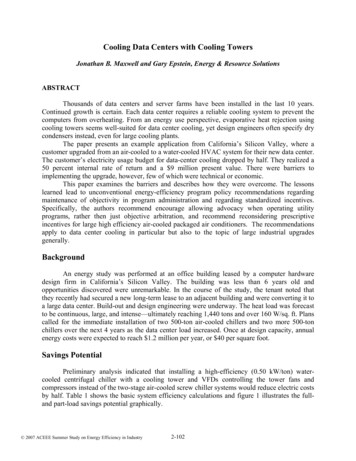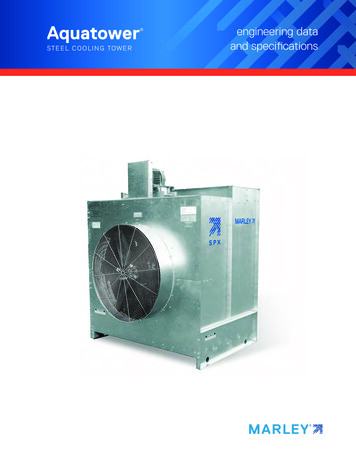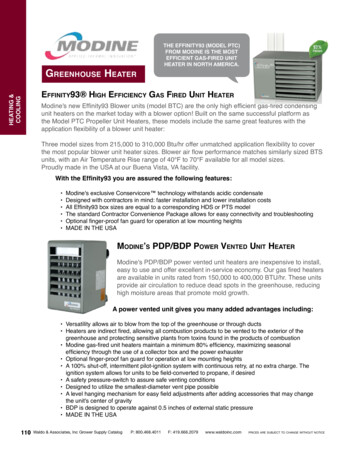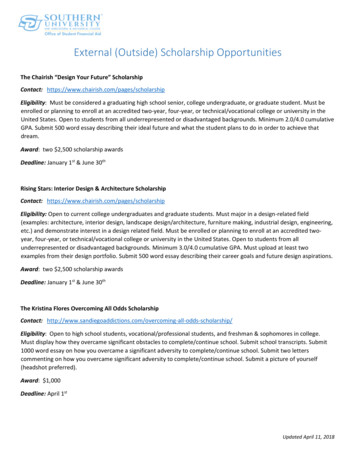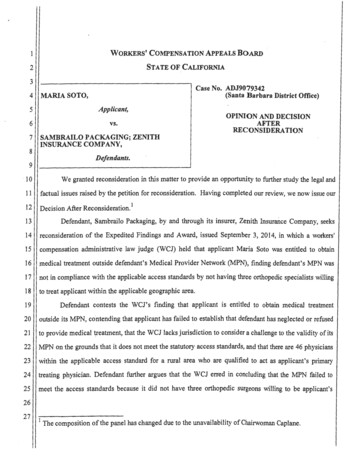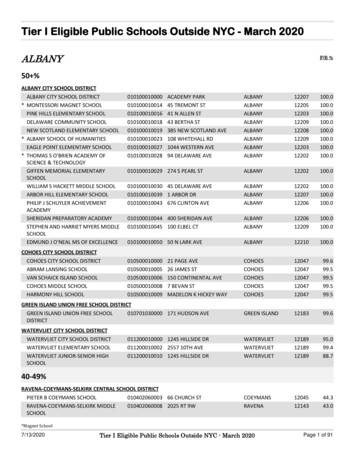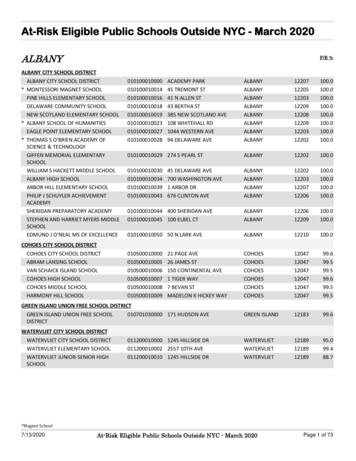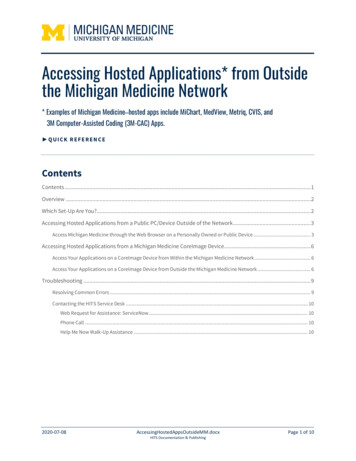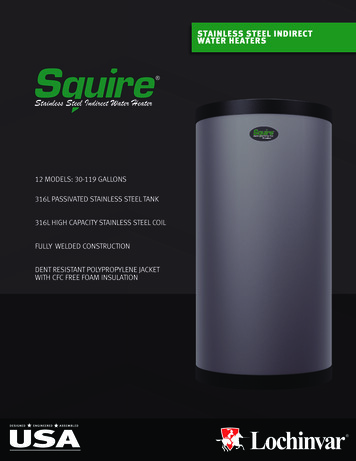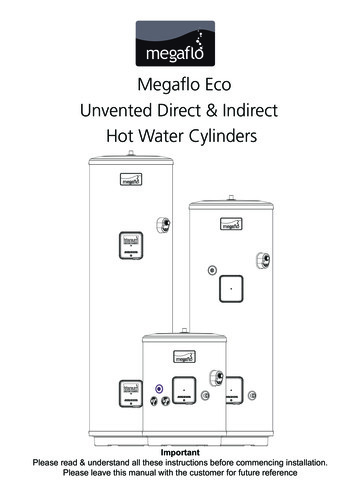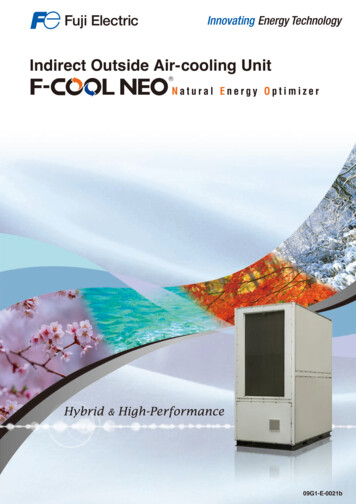
Transcription
Indirect Outside Air-cooling Unit 09G1-E-0021b
is an air-cooling system that cools in directly without needing tointroduce outside air directly into indoor areas. By taking advantage of outside air energy all throughout the year, F-COOL NEO makes possible significantly greater energy-savingoperations compared with the use of general air conditioners.SpecificationPossible carbon dioxide reductions and energysavings throughout the year CoefficientAbout 65% savings in energyreduction in electricity charges is Possiblereduction in carbon dioxide is aboutabout 123 million USD per yearSeparate typecompared with general air conditioners*236 tons per yearCooling capacity: 40 kW, Supply air (SA) temperature: 26 C, Supply air (SA) flow rate: 8500 m3/ h, Outside air (OA): Monthlymean temperature of Tokyo. Carbon dioxide basic unit*3: 0.55 kg–CO2/kWhNotes:*1: Coefficient of Performance Cooling capacity (kW) / Power consumption of air conditioner (kW). The larger the COP, is the better the efficiency.*2: Assuming that COP 3.5 for a general air conditioner.*3: Alternative values of the actual emission coefficients for each electric utility company in FY2011 as announced by the Ministry of the Environment, Goverment of Japan.ModelRated cooling capacitykWIndoor unitOutdoor unitFCA–40 O–56A404056Rating 8500(variable from 2500 to 12000)Rating 12000(variable from 2500 to 16800)Temperaturesetting Rating 26 (18 to 35)Rating 26 (18 to 35)Rating 26 (18 to 35)Temperatureprecision 2(At stable operation, in accordancewith JIS Z 8402-1) 2(At stable operation, in accordancewith JIS Z 8402-1) 2(At stable operation, in accordancewith JIS Z 8402-1)Annual average COP 10 (Tokyo)Annual average COP 9 (Tokyo)Annual average COP 9 (Tokyo)Indirect outside air cooling (brine circulation) Refrigeration cooling(R410A refrigerant circulation)Indirect outside air cooling (brine circulation) Refrigeration cooling(R410A refrigerant circulation)Indirect outside air cooling (brine circulation) Refrigeration cooling(R410A refrigerant circulation)Coefficient ofperformanceExternaldimensionsWmm 12001200120012001200 (1500)*Dmm 22001200100016001900 (1600)*Hmm 27002300270027002300kg10004405806807403-phase, 3w 200 or 400 V50/60 Hz3-phase, 3w 200 or 400 V50/60 HzProduct massPower supplyInternal Structure Diagram56 kWOutdoor unitSupply Volume setting m3/h Rating 8500air(variable from 2500 to 12000)Cooling methodIndirect outdoor air cooling operates without introducing outside air directlyso there is no need for concern about the indoor areas being contaminatedfrom the outside such as by dust (PM 2.5), SOx, or NOx.Separate type40 kWIndoor unitUnitof performance (COP*1) 10 (annual average in Tokyo) PossibleIntegrated type 40 kWItem3-phase, 3w 400 V50/60 Hz Theindirect outside air cooling circuit that drives the sensible heat exchanger and the refrigeration cooling circuit that is driven by thecompressor are integrated in the unit. (Integrated type 40 kW)EvaporatorSensible heatexchangerExhaust air (EA)CondenserIndoor unitExhaust air (EA)Return air (RA)Outside air (OA)InstallationexampleHot area Return air(RA)Cold areaReturn air (RA)Exhaust air(EA)Supply air(SA)Outside air(OA)Outdoor unitHot area Return air(RA)Cold areaSupply air(SA)Indoor unitExhaust air(EA)Outsideair(OA)F-COOL NEO F-COOL NEO(Indoor unit) (Outdoor unit)Supply air (SA)Outdoor unitHot area Return air(RA)Cold areaSupply air(SA)Exhaust air(EA)Outsideair(OA)F-COOL NEO F-COOL NEO(Indoor unit) (Outdoor unit)*: ( ) is installed on the side of a control panel.Inside air Outside airOutside air fanInside air fanOutside air (OA)PumpExpansion valveSupply air (SA)CompressorSensible heatexchangerRefrigeration cooling circuit(Circulated refrigerant: R410A)Method of Operation (HMI)Operation start and stop are performed using the includedProgrammable Operation Display (POD). Supplyair (SA) temperature and flow rate can be set.and alarm history logscan be viewed. OperationIndirect outside air cooling circuitOperation display(Circulated refrigerant: brine)POD (HMI) display1Operation andalarm history display2
is an air-cooling system that cools in directly without needing tointroduce outside air directly into indoor areas. By taking advantage of outside air energy all throughout the year, F-COOL NEO makes possible significantly greater energy-savingoperations compared with the use of general air conditioners.SpecificationPossible carbon dioxide reductions and energysavings throughout the year CoefficientAbout 65% savings in energyreduction in electricity charges is Possiblereduction in carbon dioxide is aboutabout 123 million USD per yearSeparate typecompared with general air conditioners*236 tons per yearCooling capacity: 40 kW, Supply air (SA) temperature: 26 C, Supply air (SA) flow rate: 8500 m3/ h, Outside air (OA): Monthlymean temperature of Tokyo. Carbon dioxide basic unit*3: 0.55 kg–CO2/kWhNotes:*1: Coefficient of Performance Cooling capacity (kW) / Power consumption of air conditioner (kW). The larger the COP, is the better the efficiency.*2: Assuming that COP 3.5 for a general air conditioner.*3: Alternative values of the actual emission coefficients for each electric utility company in FY2011 as announced by the Ministry of the Environment, Goverment of Japan.ModelRated cooling capacitykWIndoor unitOutdoor unitFCA–40 O–56A404056Rating 8500(variable from 2500 to 12000)Rating 12000(variable from 2500 to 16800)Temperaturesetting Rating 26 (18 to 35)Rating 26 (18 to 35)Rating 26 (18 to 35)Temperatureprecision 2(At stable operation, in accordancewith JIS Z 8402-1) 2(At stable operation, in accordancewith JIS Z 8402-1) 2(At stable operation, in accordancewith JIS Z 8402-1)Annual average COP 10 (Tokyo)Annual average COP 9 (Tokyo)Annual average COP 9 (Tokyo)Indirect outside air cooling (brine circulation) Refrigeration cooling(R410A refrigerant circulation)Indirect outside air cooling (brine circulation) Refrigeration cooling(R410A refrigerant circulation)Indirect outside air cooling (brine circulation) Refrigeration cooling(R410A refrigerant circulation)Coefficient ofperformanceExternaldimensionsWmm 12001200120012001200 (1500)*Dmm 22001200100016001900 (1600)*Hmm 27002300270027002300kg10004405806807403-phase, 3w 200 or 400 V50/60 Hz3-phase, 3w 200 or 400 V50/60 HzProduct massPower supplyInternal Structure Diagram56 kWOutdoor unitSupply Volume setting m3/h Rating 8500air(variable from 2500 to 12000)Cooling methodIndirect outdoor air cooling operates without introducing outside air directlyso there is no need for concern about the indoor areas being contaminatedfrom the outside such as by dust (PM 2.5), SOx, or NOx.Separate type40 kWIndoor unitUnitof performance (COP*1) 10 (annual average in Tokyo) PossibleIntegrated type 40 kWItem3-phase, 3w 400 V50/60 Hz Theindirect outside air cooling circuit that drives the sensible heat exchanger and the refrigeration cooling circuit that is driven by thecompressor are integrated in the unit. (Integrated type 40 kW)EvaporatorSensible heatexchangerExhaust air (EA)CondenserIndoor unitExhaust air (EA)Return air (RA)Outside air (OA)InstallationexampleHot area Return air(RA)Cold areaReturn air (RA)Exhaust air(EA)Supply air(SA)Outside air(OA)Outdoor unitHot area Return air(RA)Cold areaSupply air(SA)Indoor unitExhaust air(EA)Outsideair(OA)F-COOL NEO F-COOL NEO(Indoor unit) (Outdoor unit)Supply air (SA)Outdoor unitHot area Return air(RA)Cold areaSupply air(SA)Exhaust air(EA)Outsideair(OA)F-COOL NEO F-COOL NEO(Indoor unit) (Outdoor unit)*: ( ) is installed on the side of a control panel.Inside air Outside airOutside air fanInside air fanOutside air (OA)PumpExpansion valveSupply air (SA)CompressorSensible heatexchangerRefrigeration cooling circuit(Circulated refrigerant: R410A)Method of Operation (HMI)Operation start and stop are performed using the includedProgrammable Operation Display (POD). Supplyair (SA) temperature and flow rate can be set.and alarm history logscan be viewed. OperationIndirect outside air cooling circuitOperation display(Circulated refrigerant: brine)POD (HMI) display1Operation andalarm history display2
is a hybrid cooling only air conditioner system that operates using indirectoutside air cooling and refrigeration cooling. In response to changes in outside air temperature, the most energy-saving mode of operation is automatically selected.COP CharacteristicsAutomatic Switching of Cooling Mode Whileit is certainly possible in the cool climate of Sapporo, a high COP can also be demonstrated in Tokyo, Kuala Lumpur and New York.(Integrated type 40 kW)Exhaust air (EA)Exhaust air (EA)Returnair(RA)Exhaust air (EA)Outsideair (OA)Supplyair(SA)PumpRefrigerationcooling circuitOutsideair (OA)Supplyair(SA)CompressorIndirect outsideair cooling gerationcooling circuitOutsideair (OA)Supplyair(SA)PumpIndirect outsideair cooling circuitIndirect outsideair cooling circuitRefrigeration cooling mode DependingIndirect outside air Refrigeration cooling (hybrid operation)Indirect outsideair coolingIndirect outsideair direct outside air Refrigeration cooling(hybrid operation)Refrigerationcooling20(68)30(86)[ C]Outside air temperature( )40(104)50(122)30 W90 N0 30 E60 E90 E120 E150 E-5051015253035Dry-bulb temperature t [ C]Indirect outside aircooling modeNote:320JanuaryMaySeptember4045Hybrid 0510φ[%]-10-505101520253035Dry-bulb temperature t [ C]Indirect outside aircooling modeMarchJulyNovember4045Hybrid operationmodeAprilAugustDecember0.00050102030980 10980 520253035Dry-bulb temperature t [ C]Indirect outside aircooling mode40Hybrid operationmode0.000Absolute humidity [kg/kg (DA)]φ[%]-100.020801050.0051020500010400.02530 W90 N30 NNew York1.14Thailand:Bangkok1.220 0 India:Mumbai1.21Refrigeration cooling mode0Absolute humidity [kg/kg 08001155000.0251060 W30 NNew YorkRefrigeration cooling mode0Absolute humidity [kg/kg (DA)]980 070302520600.0306015407090520010305080090 W60 NNote: Performance varies depending on the SA and RA temperature conditions.11120 WTokyo1.15 Operation mode in each location when operating at cooling capacity of 40 kW, supply air (SA) temperature of 26 C, and return air (RA)temperature of 40 C. The lower the outside temperature is, the more energy savings are possible using the indirect outside air cooling mode.0150 WMoscow1.11Operation Mode in Various Locations10180 60 NLow Outside air temperature HighTokyoJan Feb Mar Apr May Jun Jul Aug Sep Oct Nov DecpPUE of major cities around the world is shown below.(1981 to 2010)(Source: Japan Meteorological Agency or/climfig/?tm normal&el tn〕)Automatic control in response tochanges in outside air temperatureRefrigeration cooling mode–10(14) TheRefrigeration coolingIndirect outside air coolingKuala Lumpur0(32)pPUE (partial Power Useage Effectiveness)*Maintains the cooling capacity regardlessof the outside air temperature!Rated capacity10(50)5on the outside air temperature, the unit automatically switches to one of three cooling modes.Average temperature in Kuala LumpurAverage temperature in TokyoAverage temperature in New YorkKuala Lumpur COP (annual average 6.2)Tokyo COP (annual average 10.2)New York COP (annual average 11.6)20(68)10Relationship Between Outside Air Temperature and Cooling ModeSupply air temp. : 26 CReturn air temp. : 40 CAir flow rate: 8500 m3/hCooling capacity: 40 kW30(86)15CompressorRefrigerationcooling circuit40(104)Other common conditions:Supply air temp. : 26 CCooling capacity: 40 kW20PumpIndirect outside air Refrigeration cooling mode(hybrid operation)Indirect outside air cooling mode T 14 K, supply air: 8500 m3/h T 12 K, supply air: 10000 m3/h T 10 K, supply air: 12000 m3/hAverage monthly temperature [ C ] / COP [ – ][ F ] / COP [ – ]on the outside air temperature, the unit automatically switches to one of three cooling modes.COP [ – ] Depending30 S30 SMalaysia:Kuala Lumpur1.2160 S90 S30 W60 S0 30 E60 E-20(-4)-15(5)90 E-10(14)120 E-50(23) (32)5(41)150 E180 150 W10(50)152025(59) (68) (77)30(86)120 W90 W3540(95) (104)[ C][ F]60 W90 S30 WCPD/JMA* Note: That in this catalog, rather than the power consumption of the datacenter as a whole(PUE) , the power consumption of only the airconditioner is determined and displayed as the partial pue (pPUE).4
is a hybrid cooling only air conditioner system that operates using indirectoutside air cooling and refrigeration cooling. In response to changes in outside air temperature, the most energy-saving mode of operation is automatically selected.COP CharacteristicsAutomatic Switching of Cooling Mode Whileit is certainly possible in the cool climate of Sapporo, a high COP can also be demonstrated in Tokyo, Kuala Lumpur and New York.(Integrated type 40 kW)Exhaust air (EA)Exhaust air (EA)Returnair(RA)Exhaust air (EA)Outsideair (OA)Supplyair(SA)PumpRefrigerationcooling circuitOutsideair (OA)Supplyair(SA)CompressorIndirect outsideair cooling gerationcooling circuitOutsideair (OA)Supplyair(SA)PumpIndirect outsideair cooling circuitIndirect outsideair cooling circuitRefrigeration cooling mode DependingIndirect outside air Refrigeration cooling (hybrid operation)Indirect outsideair coolingIndirect outsideair direct outside air Refrigeration cooling(hybrid operation)Refrigerationcooling20(68)30(86)[ C]Outside air temperature( )40(104)50(122)30 W90 N0 30 E60 E90 E120 E150 E-5051015253035Dry-bulb temperature t [ C]Indirect outside aircooling modeNote:320JanuaryMaySeptember4045Hybrid 0510φ[%]-10-505101520253035Dry-bulb temperature t [ C]Indirect outside aircooling modeMarchJulyNovember4045Hybrid operationmodeAprilAugustDecember0.00050102030980 10980 520253035Dry-bulb temperature t [ C]Indirect outside aircooling mode40Hybrid operationmode0.000Absolute humidity [kg/kg (DA)]φ[%]-100.020801050.0051020500010400.02530 W90 N30 NNew York1.14Thailand:Bangkok1.220 0 India:Mumbai1.21Refrigeration cooling mode0Absolute humidity [kg/kg 08001155000.0251060 W30 NNew YorkRefrigeration cooling mode0Absolute humidity [kg/kg (DA)]980 070302520600.0306015407090520010305080090 W60 NNote: Performance varies depending on the SA and RA temperature conditions.11120 WTokyo1.15 Operation mode in each location when operating at cooling capacity of 40 kW, supply air (SA) temperature of 26 C, and return air (RA)temperature of 40 C. The lower the outside temperature is, the more energy savings are possible using the indirect outside air cooling mode.0150 WMoscow1.11Operation Mode in Various Locations10180 60 NLow Outside air temperature HighTokyoJan Feb Mar Apr May Jun Jul Aug Sep Oct Nov DecpPUE of major cities around the world is shown below.(1981 to 2010)(Source: Japan Meteorological Agency or/climfig/?tm normal&el tn〕)Automatic control in response tochanges in outside air temperatureRefrigeration cooling mode–10(14) TheRefrigeration coolingIndirect outside air coolingKuala Lumpur0(32)pPUE (partial Power Useage Effectiveness)*Maintains the cooling capacity regardlessof the outside air temperature!Rated capacity10(50)5on the outside air temperature, the unit automatically switches to one of three cooling modes.Average temperature in Kuala LumpurAverage temperature in TokyoAverage temperature in New YorkKuala Lumpur COP (annual average 6.2)Tokyo COP (annual average 10.2)New York COP (annual average 11.6)20(68)10Relationship Between Outside Air Temperature and Cooling ModeSupply air temp. : 26 CReturn air temp. : 40 CAir flow rate: 8500 m3/hCooling capacity: 40 kW30(86)15CompressorRefrigerationcooling circuit40(104)Other common conditions:Supply air temp. : 26 CCooling capacity: 40 kW20PumpIndirect outside air Refrigeration cooling mode(hybrid operation)Indirect outside air cooling mode T 14 K, supply air: 8500 m3/h T 12 K, supply air: 10000 m3/h T 10 K, supply air: 12000 m3/hAverage monthly temperature [ C ] / COP [ – ][ F ] / COP [ – ]on the outside air temperature, the unit automatically switches to one of three cooling modes.COP [ – ] Depending30 S30 SMalaysia:Kuala Lumpur1.2160 S90 S30 W60 S0 30 E60 E-20(-4)-15(5)90 E-10(14)120 E-50(23) (32)5(41)150 E180 150 W10(50)152025(59) (68) (77)30(86)120 W90 W3540(95) (104)[ C][ F]60 W90 S30 WCPD/JMA* Note: That in this catalog, rather than the power consumption of the datacenter as a whole(PUE) , the power consumption of only the airconditioner is determined and displayed as the partial pue (pPUE).4
With the, the heat source equipment needed for generalair-conditioning systems is no longer required. Even when compared to outside air direct air-conditioning systems the F‒COOL NEO is a simple system that makes energy-saving operations possible.Comparison with an Air-Conditioning System Using Outside AirExamples of Applications Theprocess of mixing outside air and exhaust air that is required by a direct outside air air-conditioning system is not required, andthe control of humidity is easy (because there are no abrupt changes in humidity). In addition, since the mixing chamber used for themixing process is also unnecessary, the duct layout can be simplified. Since the dust removal filters and the summer-winter switchover of operations that are required by outside air direct air-conditioningsystem are not required, energy-saving operations are possible all throughout the year. Insuch fields that require air conditioned cooling with clean air throughout the entire year, from data centers to precision machining, andfoods to pharmaceuticals, F– COOL NEO is the perfect air conditioning system.Building-Type Data Center Direct Outside Air System (Utilize outside air)Indirect outside air-cooling unit Server roomDirect outside air-cooling unitExhaust airServer roomExhaust air ServerServerRefrigeratorOutside airServer roomOutside airExamples of installation for a building-type data center and the flow of airOutside air filter(Dust, salt damage)Humidifier(for indoor humidifier control)Integrated TypeSeparate TypeModular-Type Data CenterContainer-Type Data CenterIndirect outside cooling unitRefrigeratorComparison of Air-Conditioning Systems Amongthe air-conditioning systems that use outside air, an outside air indirect air-conditioning system (F-COOL NEO) is the best.Centrifugal chiller Air handling unit systemAir-cooled packaged unit(PU) systemIndirect outside air air-conditioning system (F-COOL NEO)Integrated typeSeparate typeIndoor unitCOPUse of outside air energyRisk of water supply outage,water freezingMaintenanceSpaceWorkabilityImplementation in stages Outdoor unit Symbol legend: Best, Good, Fair, Not good56
With the, the heat source equipment needed for generalair-conditioning systems is no longer required. Even when compared to outside air direct air-conditioning systems the F‒COOL NEO is a simple system that makes energy-saving operations possible.Comparison with an Air-Conditioning System Using Outside AirExamples of Applications Theprocess of mixing outside air and exhaust air that is required by a direct outside air air-conditioning system is not required, andthe control of humidity is easy (because there are no abrupt changes in humidity). In addition, since the mixing chamber used for themixing process is also unnecessary, the duct layout can be simplified. Since the dust removal filters and the summer-winter switchover of
is an air-cooling system that cools in directly without needing to introduce outside air directly into indoor areas. By taking advantage of outside air energy all throughout the year, F-COOL NEO makes possible significantly greater energy-saving operations compared w

